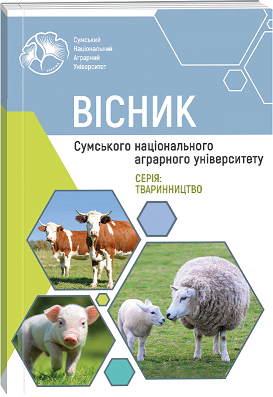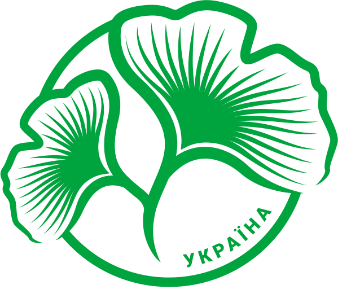EFFICIENCY OF BREEDING OF HYBRID PIGLETS OF DIFFERENT WEIGHTS BY CORRECTION OF THE FEEDING SYSTEM
Abstract
The productivity of piglets for rearing was studied depending on the method of changing rations during rearing. It was established that piglets that received differentiated feeding of a separate group depending on the actual weight had at the end of rearing – 1.19% less death, 0.17% less share of sanitary defects and 1.37% better preservation. They found 6.3% higher average daily gains and 2.2% relative gains, which led to a 6.3% improvement in absolute gains and a 4.9% improvement in animal weight at the end of rearing. It was determined that piglets whose rations were adjusted according to the average weight of animals in the machine had a 10.70% lower average daily consumption of the first most expensive feed, a 3.8% higher consumption of the second pre-starter combined feed and a 16.3% increase in the cheapest starter feed. Due to this, they consumed 13.3% less of the first prestarter, 6.0% more than the second prestarter, and 8.1% of the cheapest starter feed during the growing period compared to animals whose diet was adjusted according to the average weight of the animals in the group . In general, the piglets of the experimental group consumed 2.9% more feed of all recipes during the period of rearing, compared to the counterparts of the control group. It was proven that the cost of the first pre-starter compound feed consumed was 13.3% lower, despite the 6.0% higher cost of the second pre-starter compound feed and the 8.1% cost of starter feed, which caused a decrease in the cost of all feed formulations by 0.8% in animals that the diet was changed according to the weight of the animals in the group. The lower cost of the first prestater contributed to a 0.8% decrease in the feed cost of growth, in parallel with a 4.9% increase in the weight of piglets at the end of rearing and a 6.1% decrease in the cost of one kilogram of growth in animals whose diet was adjusted depending on the weight of the animals in the machine. Due to the higher intensity of growth and, as a result, greater live weight at the end of rearing, the cost of one piglet at the end of rearing was 4.9% higher compared to analogues whose diet was adjusted depending on the average weight of the animals in the machine, which, in parallel with the decrease in its cost, contributed to the increase by 21.80% of the profit from growing one head and an improvement of 18.06% in the profitability of the same the growing process.
References
2. Bai, X., Plastow, G. S. (2022). Breeding for disease resilience: opportunities to manage polymicrobial challenge and improve commercial performance in the pig industry. CABI Agric Biosci 3, 6. https://doi.org/10.1186/s43170-022-00073-y
3. Blavi, L., Solà-Oriol, D., Llonch, P., López-Vergé, S., Martín-Orúe, S. M., & Pérez, J. F. (2021). Management and Feeding Strategies in Early Life to Increase Piglet Performance and Welfare around Weaning: A Review. Animals: an open access journal from MDPI, 11(2), 302. https://doi.org/10.3390/ani11020302
4. Camp Montoro, J.; Manzanilla, E.G.; Solà-Oriol, D.; Muns, R.; Gasa, J.; Clear, O.; Calderón Díaz, J.A. (2020). Predicting Productive Performance in Grow-Finisher Pigs Using Birth and Weaning Body Weight. Animals, 10, 1017. https://doi.org/10.3390/ani10061017
5. Davoudkhani, M., Mahé, F., Dourmad, J. Y., Gohin, A., Darrigrand, E., Garcia-Launay, F. (2020). Economic optimization of feeding and shipping strategies in pig-fattening using an individual-based model. Agricultural Systems,184, 102899.10.1016/j.agsy.2020.102899
6. Faccin, J. E. G., Laskoski, F., Cemin, H. S., Mellagi, A. P. G., Bernardi, M. L., Ulguim, R. R., Bortolozzo, F. P., Tokach, M. D. (2020). Evaluating the impact of weaning weight and growth rate during the first week post weaning on overall nursery performance. J Swine Health Prod., 28(2), 7078. http://www.aasv.org/shap.html.
7. Farmer, C., Edwards, S. A. (2022). Review: Improving the performance of neonatal piglets, animal, 16(2), 100350. https://doi.org/10.1016/j.animal.2021.100350.
8. Filimonov V.I. (2021). Fiziolohiia liudyny [Human physiology]. All-Ukrainian specialized publishing house "Medicine". Kyiv, p. 488. https://www.medpublish.com.ua/phiziologija-ljudini-pidruchnik-vnz-r-a-v-philimonov-3ye-vid-vipr/p-555.html [in Ukrainian].
9. Fix, J. S., Cassady, J. P., Holl, J. W., Herring, W. O., Culbertson, M. S., & See, M. T. (2010). Effect of piglet birth weight on survival and quality of commercial market swine. Livestock Science, 132(1-3), 98-106.
10. Guy, S. Z., Thomson, P. C., & Hermesch, S. (2012). Selection of pigs for improved coping with health and environmental challenges: Breeding for resistance or tolerance? Frontiers in Genetics, 3, 31610. https://doi.org/10.3389/fgene.2012.00281
11. Holman, D. B., Gzyl, K. E., Mou, K. T., Allen, H. K. (2021). Weaning age and its effect on the development of the swine gut microbiome and resistome. mSystems, 6:e00682-21. https://doi.org/10.1128/mSystems.00682-21.
12. Huting, A. M. S., Sakkas, P., Wellock, I. (2018). Once small always small? To what extent morphometric characteristics and post-weaning starter regime affect pig lifetime growth performance. Porc Health Manag., 4, 21. https://doi.org/10.1186/s40813-018-0098-1
13. Jankowiak, H., Balogh, P., Cebulska, A., Vaclavkova, E., Bocian, M., Reszka, P. (2020). Impact of piglet birth weight on later rearing performance. Vet Med-Czech., 65, 473–479.
14. Jarvis, S., et al. (2008). Effects of weaning age on the behavioural and neuroendocrine development of piglets. Applied Animal Behaviour Science. 1, 166–181.
15. Koketsu, Y., Tani, S., Iida, R. (2017). Factors for improving reproductive performance of sows and herd productivity in commercial breeding herds. Porc Health Manag., 3, 1. https://doi.org/10.1186/s40813-016-0049-7
16. Kuzmenko, M. V. (2012). Efektyvnist vidhodivli molodniaku svynei za riznoi pochatkovoi masy [Efficiency of fattening of young pigs at different starting weights]. Visnyk ahrarnoi nauky. 12, 77–78. [in Ukrainian].
17. Ladyka, V. I., Khmelnychyi, L. M., Povod, M. G. [etc.] (2023). Tekhnolohiia vyrobnytstva ta pererobky produktsii tvarynnytstva: pidruchnyk dlia aspirantiv [Technology of production and processing of livestock products: a textbook for graduate students]. Odesa: Oldi+. Edited by V. I. Ladyka and L. M. Khmelnychyi, p. 244. [in Ukrainian].
18. Leibbrandt, V. D. Ewan, J. R. C., Zimmerman, D. R. (1975). Effect of weaning and age at weaning on baby pig performance. Anim. Sci., 40, 1077–1080.
19. Lykhach V. Ya., Povod M. H., Shpetnyi M. B., Nechmilov V. M., Lykhach A. V., Mykhalko O. H., Barkar Ye. V., Lenkov L. H., Kucher O. O. (2023). Optymizatsiia tekhnolohichnykh rishen utrymannia i hodivli svynei v umovakh promyslovoi tekhnolohii: monohrafiia [Optimization of technological solutions for keeping and feeding pigs in conditions of industrial technology: monograph]. Mykolaiv: Ilion. 518 p. [in Ukrainian].
20. Mykhalko O. H. (2021). Suchasnyi stan ta shliakhy rozvytku svynarstva v sviti ta Ukraini [The current state and ways of development of pig farming in the world and in Ukraine]. Scientific Bulletin of Sumy NAU. The series: "Livestock", Issue 3(46), pp. 60–77. [in Ukrainian].
21. Patience, J. F., Rossoni-Serão, M. C., Gutiérrez, N. A. (2015). A review of feed efficiency in swine: biology and application. J Animal Sci Biotechnol., 6, 33. https://doi.org/10.1186/s40104-015-0031-2
22. Pelykh, V. H., Chernyshov, I. V., Levchenko, M. V. (2012). Vplyv velykoplidnosti ta kompensatorskoho rostu na dynamiku zhyvoi masy porosiat u rannomu ontohenezi [The influence of high fertility and compensatory growth on the dynamics of live weight of piglets in early ontogeny]. Tavriiskyi naukovyi visnyk, 82, 137–140. http://www.tnv-agro.ksauniv. ks.ua/archives/82_2012/27.pdf [in Ukrainian].
23. Pelykh, V. H., Chernyshov, I. V., Levchenko, M. V. (2014). Vplyv velykoplidnosti ta ta stati na rist i rozvytok porosiat u pidsysnyi period [Influence of high fertility and gender on growth and development of piglets during the weaning period]. Tavriiskyi naukovyi visnyk, 88, 252–256. http://www.tnv-agro.ksauniv.ks.ua/archives/88_2014/50.pdf [in Ukrainian].
24. Povod M. H., Lykhach V. Ya., Voloshynov V. V., Koroban M. P., Bondarska O. M. (2022). Rozvytok hlobalnoho svynarstva [Development of global pig farming] Taurian Scientific Herald. Series: Agricultural sciences. Kherson State Agrarian and Economic University. Kherson: "Helvetika" Publishing House, Issue 125. pp. 171-175. DOI https://doi.org/10.32851/2226-0099.2022.125.24 [in Ukrainian].
25. Povod M., Bondarska O., Lykhach V., Zhyshka S., Nechmilov V. (2021). Tekhnolohiia vyrobnytstva produktsii svynarstva : navchalnyi posibnyk [Production technology of pig production: a study guide]. K. : Scientific and Methodological Center of VFPO, 360 p. [in Ukrainian].
26. Povod, M. G., Mykhalko, O. G., Izhboldina, О. O., Gutyj, B. V., Verbelchuk, T. V., Borshchenko, V. V., & Koberniuk, V. V. (2023). The influence of piglet weight placed for rearing on their productive quality and efficiency of rearing. Ukrainian Journal of Veterinary and Agricultural Sciences, 6(2), 37–43. doi: 10.32718/ujvas6-2.07
27. Quiniou, N., Dagorn, J., Gaudré, D. (2002). Variation of piglets’ birth weight and consequences on subsequent performance, Livestock Production Science, 78(1), 63–70. https://doi.org/10.1016/S0301-6226(02)00181-1.
28. Schinckel, A. P., Cabrera, R., Boyd, R. D., Jungst, S., Booher, C., Johnston, M., Einstein, M. E. (2007). Impact of Birth and Body Weight at Twenty Days on thePostweaning Growth of Pigs with Different Weaning Management, The Professional Animal Scientist, 23(3), 197–210. https://doi.org/10.15232/S1080-7446(15)30965-7.
29. Schinckel, A. P., Einstein, M. E., Jungst, S., Booher, C., Newman, S. (2010). Evaluation of the Impact of Pig Birth Weight on Grow-Finish Performance, Backfat Depth, and Loin Depth, The Professional Animal Scientist, 26(1), 51-69, https://doi.org/10.15232/S1080-7446(15)30557-X.
30. Shvachka, R., Povod, M., Mykhalko, O., Shpetnyi, M., Korzh, O., Verbelchuk, T., Shcherbyna, O. (2022). Reproductive qualities of sows at different durations of previous lactation. Scientific Papers Series Management, Economic Engineering in Agriculture and Rural Development, 22(1), 579–584.
31. Tishchenko, O. S. Povod M. H., Hutyi B. V., Myronenko O. I., Kuzmenko L. M., Kalinichenko H. I., Boiko A. O. (2022). Efektyvnist doroshchuvannia hibrydnykh porosiat z riznoiu masoiu pry postanovtsi za ridkoi systemy yikh hodivli [The effectiveness of growing hybrid piglets with different weights when placed under a liquid feeding system]. Scientific Bulletin of the LNUVMB named after S.Z. Gzhitskyi. Series: Agricultural Sciences, Issue 25, № 99, pp. 217-225. https://orcid.org/0000-0003-3799-0880 DOI: https://doi.org/10.32718/nvlvet-a9936 [in Ukrainian].
32. Valentim, J. K., Mendes, J. P., Caldara, F. R., Pietramale, R. T. R. & Garcia, R. G. (2021). Meta-analysis of relationship between weaning age and daily weight gain of piglets in the farrowing and nursery phases. South African Journal of Animal Science, 51(3), 332–338. http://dx.doi.org/10.4314/sajas.v51i3.6
33. VanderWaal, K., Deen, J. (2018). Global trends in infectious diseases of swine. PNAS, 15(45), 11495–11500. https://doi.org/10.1073/pnas.1806068115
34. Wenk, C., Pfirter, H. P., Bickel, H. (1980). Energetic aspects of feed conversion in growing pigs, Livestock Production Science, 7(5), 483–495. https://doi.org/10.1016/0301-6226(80)90086-X.

 ISSN
ISSN  ISSN
ISSN 



